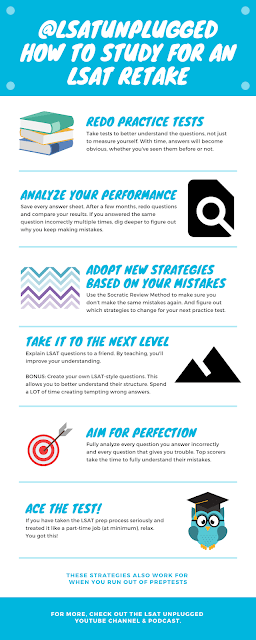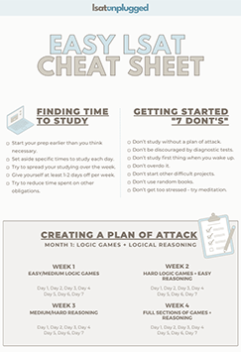So, you’re planning to retake the LSAT.
It’s incredibly important to figure out what you did wrong the first time around and plan what you’ll do differently this time.
Maybe you didn’t have enough time to study for the LSAT. Maybe you just didn’t use it wisely. I recommend a minimum of 3 months.
It could be you didn’t use the right LSAT prep books.
Maybe you didn’t spend enough time on a certain section. Maybe your approach just wasn’t flexible enough.
The biggest concern students have is “there aren’t enough PrepTests” and/or they’ve “already used up too many PrepTests.” There are more than 90 PrepTests.
Of course, having to resort to the older exams and having to redo newer ones isn’t ideal, but it shouldn’t be a major concern.
This article will help you figure out to move forward as you prepare for an LSAT retake.
Whitney writes:
“My concern is whether I need to do question type practice or just simply do more full length and section practice.”
Ideally, you’ll do a mix of practicing specific question-types and doing full-length sections. You’ll end with full-length exam practice.
The real issue is figuring out what went wrong the first time around and using that info as you plan your retake schedule.
If you aren’t having difficulty with a specific type of question, then full-length section/exam practice is all you need.
However, this situation is rare – most people have more difficulty with some question-types than others.
This means you’ll probably need to “Drill, baby, drill.”
If you didn’t cancel your most recent LSAT score, review that exam and make a list of the question-types you answered incorrectly and/or that gave you difficulty.
If you did cancel it, do a few full exams (untimed) to determine question-types that give you difficulty.
If there were relatively few types that gave you difficulty, you might just want to spend a week or two drilling those types and then move onto doing a practice test or two each week.

The following 3-month retake schedule assumes you already did most/all of what I recommend in my LSAT study plans for first-timers. If you did little or none of the things contained in those schedules, use those instead.
This schedule also assumes there are 4 Logical Reasoning question-types that give you difficulty. (Here’s an example of one way you might analyze a Logical Reasoning question in more detail.)
Finally, it assumes you’ve already seen/used dozens of the most recent PrepTests in your prep the first time around.
Feel free to alter this schedule according to your needs.
***
Week 1: Study my articles on Logical Reasoning. Do several dozen questions of that type (untimed) from exams you’ve never touched, if any. Review all questions that give you difficulty and write explanations for why each wrong answer choice is wrong and why the right answer choice is right.
Week 2: Do the same with another type.
Week 3: Do the same with another type.
Week 4: Do the same with another type.
Week 5: Do the same with another type.
Week 6: Do the same with another type.
Week 7: Do the same with another type, or read my articles on Reading Comprehension and do several timed sections of Reading Comp.
Week 8: Complete 3 recent LSAT PrepTests (timed). Splice in sections from another to simulate the experimental section. Review all wrong answers and write out explanations for them. Review each exam on alternating days.
Week 9: Complete 3 recent LSAT PrepTests (timed). Splice in sections from another to simulate the experimental section. Review all wrong answers and write out explanations for them. Review each exam on alternating days.
Week 10: Complete 3 recent LSAT PrepTests (timed). Splice in sections from another to simulate the experimental section. Review all wrong answers and write out explanations for them. Review each exam on alternating days.
Week 11: Complete 3 recent LSAT PrepTests (timed). Splice in sections from another to simulate the experimental section. Review all wrong answers and write out explanations for them. Review each exam on alternating days.
Week 12: Complete 3 recent LSAT PrepTests (timed). Splice in sections from another to simulate the experimental section. Review all wrong answers and write out explanations for them. Review each exam on alternating days.
Weeks 9-12: should include 4-section exams (the 4th section simulates the experimental section). See Preparing for the Experimental Section for why, where, and how to include “experimental” sections.
***
I know this schedule will include exams you’ve already done. Remember, I said I’m assuming you already used the newer PrepTests the first time around. That’s okay.
Your goal shouldn’t always be to get an accurate gauge of your progress. No one (except maybe your parents) is going to give you a prize for how you do on a practice exam. The real thing is all that matters in the end.
Even if you’ve already done these exams (and remember them well) will you really remember all the answers? If you really think you will, do a previously-taken exam or two under timed conditions. Just see if you get perfect scores on them. If you don’t, it means you still have something to learn from them.
Besides, doing them in chronological/numerical order puts at least a few months between you and any particular exam. This means if/when you answer questions correctly, it’s more likely this will be due to your understanding of the questions’ logic rather than your memory.
If you’re really concerned about remembering them, substitute those for exams you’ve never seen before.
However, it’s important to redo the newer PrepTests to ensure that you fully understand them because the LSAT changes over time.
You got this!

